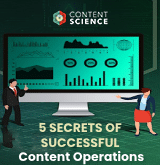
My career in content began 15 years ago, when websites were in their infancy and Hilton managed only one global U.S. English site. Since then, we have expanded into a multi-disciplinary team of copywriters, content editors, image editors and localization specialists supporting more than 5,000 hotel websites across 14 brands in 22 languages.
Our growth has been met with a rapidly-evolving landscape. Customers can choose to book with us on their desktop, mobile, app or third-party channels, via wearables, even voice assistants.
As a leading global hospitality company in a world of mass distribution, we still face the primary challenge of how to shift to a decoupled omnichannel model at scale, enabling us to communicate with our guests whenever they want, however they want. Believe me, it’s a tall order.
Here are some of the key challenges you may encounter in moving to decoupled omnichannel content, along with my thoughts on how to tackle them.
To Migrate or Not Migrate?
Before starting to redesign a future model for migration and creation of omnichannel content, it is useful to make clear distinctions between what exists in your library of content today and what new content will be required. I would recommend breaking this up into the following four categories:
- What is valuable in its current form
- What is valuable, but requires repurposing
- What no longer serves a purpose in tomorrow’s world
- What needs to be created
Performing an internal audit of each of our hotel brands set a baseline for our content needs. Setting up a sample for property content helped create a framework for us to plan large-scale content areas.
Reuse – Reduce – Recycle
When I began my career in content, it was primarily perceived as a database management task. And that seemed to be the norm – according to Content Science’s Content Operations study, 35% of companies report being in the scaling stage of content maturity, just beginning to grow content operations.
To quote Jonathan Perelman, Head of Digital Ventures at ICM Partners:
”Content is king, but distribution is queen and she wears the pants.”
But in order to truly repurpose content, regardless of channel, it is necessary to decouple content storage from content presentation. Getting the right CMS and implementation approach is key to making omnichannel a reality.
Historically, content would be managed for placement. For example, if we have a marketing message to display on a hotel homepage, the content is stored in that hotel’s CMS homepage file. The message is written and formatted specifically for that location, which has two major disadvantages:
- If we have a message we want to display for every hotel in a brand (e.g. Hampton by Hilton), that equals more than 2,000 tasks for our team to execute.
- That message will have an associated image cropped specifically for that use, the copy will be written to fit that space exactly, and it will all be wrapped in HTML to suit that page placement – meaning it isn’t easy to take that content and reuse it on other channels.
But moving to an omnichannel approach to content means decoupling content from the presentation: Content should be created for purpose rather than placement. That way the content can be quickly and easily repurposed across brands, hotels, and channels, delivering a consistent experience for customers no matter what channels are selected. It also increases operational efficiency and speed-to-market.
Content automation, according to that same Content Science study, is a key factor in mature content operations (along with leadership and content intelligence.)
Physical Storage and Logical Mapping of Content A Map of the Warehouse
With a decoupled content approach, another challenge is determining how to physically label and store each content component and at scale. We previously attributed each component to a specific web page document in the CMS which allowed for a very simple branching structure. For example, Brand>Property>Web Page.
To implement a new decoupled omnichannel approach, it is advisable to set out clear content types and labels, attributing them to document types without ties to placement, ensuring you have the flexibility to attribute content to multiple placements.
For example, a story, event, or person could reside within a brand but could also be attributed to a property. You may also have to allow for potential channel-specific variations in content, such as paragraph vs. bullet formats.
The “We’ve Always Done It This Way” Separation Anxiety
In companies with a centralized content team, there tends to be a degree of resistance to changing how things are done. However, shifting to an omnichannel approach will inevitably require changes to the operating model and it is important to ensure that key stakeholders and content contributors are familiar and comfortable with the new approach.
Engaging key stakeholders and asking them to contribute to the new model via workshops and interviews is a good way of ensuring everyone is fully on board. This can also help develop baseline requirements for the new model. Explaining the reasons for moving to omnichannel and the benefits and efficiencies this brings – including flexibility and reuse of content and exciting new opportunities inherent with new channels – are guaranteed to get everyone on board.
Educating stakeholders and partners on the value of the approach should be an ongoing process during the entire implementation period.
Flexibility of Presentation Layer
The interface that complements the decoupled website also has to be flexible. It has to control the look of the distributed content, and ensure that the content operation can bulk deploy content to save time and resources, but also publish on-demand when applicable.
With a decoupled system, you can store content from across all enterprises in its pure form while also using the presentation tool to control what each individual website looks like.
Who Owns What Content?
When moving to decoupled, omnichannel content, you will likely have to consider how the omnichannel model affects the delivery, ingestion, management, and distribution of content from all areas of your business.
With the omnichannel approach, you should carefully consider what changes may need to be made to the operating model clearly defining roles and responsibilities, and considering the elements of governance and workflow such as:
- Should other corporate teams have direct access to publish content in the CMS, such as personalization?
- Who should own placement of content against multi-channel?
- Should content operations have the right to reject content that is not in line with your strategy?
Nothing Is Impossible
Hilton is constantly expanding its footprint globally, both from a property and a hotel brand perspective. With any growing company, you will have to ensure that your content model can grow and scale accordingly.
Whilst developing our CMS and presentation layer, we are constantly thinking about how we will lay the foundation to:
- Quickly set up new hotel brands and properties by copying existing formats and allowing enough flexibility to add or remove content types as required
- Constantly test and learn by implementing analytics and tools that allow us to determine what content works – and what doesn’t
- Prepare our enterprise for growing technologies such as AI to deliver personalized and meaningful content
As we work through this transition towards omnichannel content, we will continue to develop our strategy and processes. This will ensure we can truly deliver content as a service in the appropriate channels whilst driving increasing efficiencies across the enterprise.
Events, Resources, + More
5 Secrets of Content Ops Success: Webinar
Learn how the most successful organizations scale and mature content operations. Based on our research with 700+ content leaders and professionals.
The Ultimate Guide to End-to-End Content
Discover why + how an end-to-end approach is critical in the age of AI with this comprehensive white paper.
The Content Advantage Book
Learn more about the much-anticipated third edition of the highly rated book by Colleen Jones. Preorder the electronic version.
20 Signs of a Content Problem in a High-Stakes Initiative
Use this white paper to diagnose the problem so you can achieve the right solution faster.
Workshop: Are You Ready for AI?
Is your organization really ready for AI at scale? Let the Content Science team guide your leaders through assessing 4 areas of readiness.
Upskill with Content Science Academy
Training for modern content roles through on-demand certifications + courses or live workshops.








Comments
We invite you to share your perspective in a constructive way. To comment, please sign in or register. Our moderating team will review all comments and may edit them for clarity. Our team also may delete comments that are off-topic or disrespectful. All postings become the property of
Content Science Review.